The Samsung Galaxy S6 and S6 edge Review
by Joshua Ho on April 17, 2015 9:00 AM EST- Posted in
- Smartphones
- Samsung
- Mobile
- Galaxy S6
- Galaxy S6 Edge
Battery Life
At this point, it really goes without saying that battery life can make or break the experience of a smartphone. The anxiety that is associated with running out of battery is probably one of the worse experiences to have when using a smartphone, which is why good battery life is important. In theory, a phone should never run out of battery in a single day no matter the use case, but battery life is a complex issue to address. It’s common to see people assume that battery capacity and battery life are closely correlated, but this completely ignores total system power draw. Last year, one of the best examples of this was the One M8 compared against the Galaxy S5, which showed a slight edge in favor of the One M8 despite the smaller battery.
The Galaxy S6 and S6 edge are in a similarly peculiar situation. For the past few years, it has gone without saying that battery capacity would increase from year to year, but for the first time ever, Samsung has gone backwards in this regard. The Galaxy S6 has a 2550 mAh, 3.85V battery, which is 91% of the Galaxy S5’s battery. If we simply looked at this metric, it would be rather trivial to simply write off the Galaxy S6 as worse than the S5 in battery life. As previously mentioned, this is a simplistic view of the situation and ignores the other half of the battery life equation.
As a result, we must test battery life holistically, which is far from trivial in most cases. One of the first problems we can encounter in trying to test battery life is display brightness, which can significantly affect results in a battery life test. Although it’s common to standardize at 50% brightness, 50% brightness can be as low as 80 nits or as high as 250 nits depending upon the brightness curve that the OEM sets. In order to avoid this pitfall, we test battery life with the display set to have a 200 nit brightness when displaying a white image. In addition, it’s necessary to have appropriate tests that cover the full curve of performance and power, ranging from a display-bound web browsing use case to sustained, intense CPU and GPU loads.
As with most reviews, our first battery life test is the standard web browsing workload, which loads a set of webpages at a fixed interval, with sufficient time between each page load to ensure that the modem and SoC can reach an idle state. This helps to ensure that faster SoCs aren’t penalized in this test. This test doesn’t exactly match real-world web browsing patterns, but it will give a good idea of relative performance per watt at a constant level of performance.
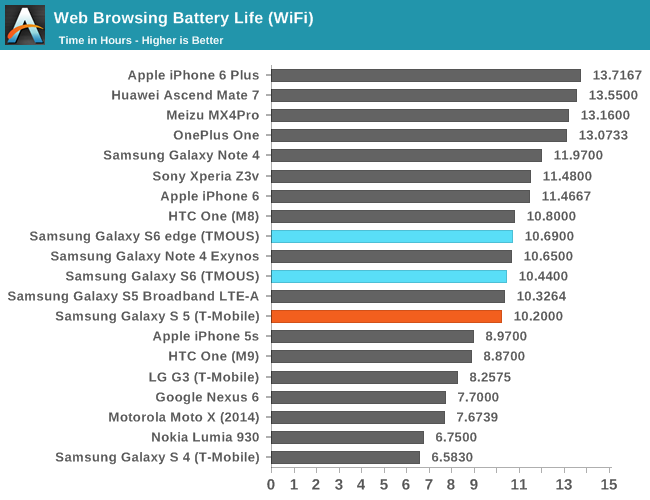
In web browsing, the Galaxy S6 manages to keep battery life while on WiFi at approximately the same level as the Galaxy S5. It’s likely that a combination of the newer Broadcom BCM4358, upgraded AMOLED display, and the Exynos 7420 helped to keep battery consumption relatively constant here, which represents a 10-15% overall power efficiency increase in this test. It’s likely that we’re mostly looking at differences in display efficiency when comparing the 1440p panel of the S6 to the 1080p panel of the S5. It’s definitely impressive that Samsung has pulled this off, but I do wonder what the result would be if Samsung stayed at 1080p.
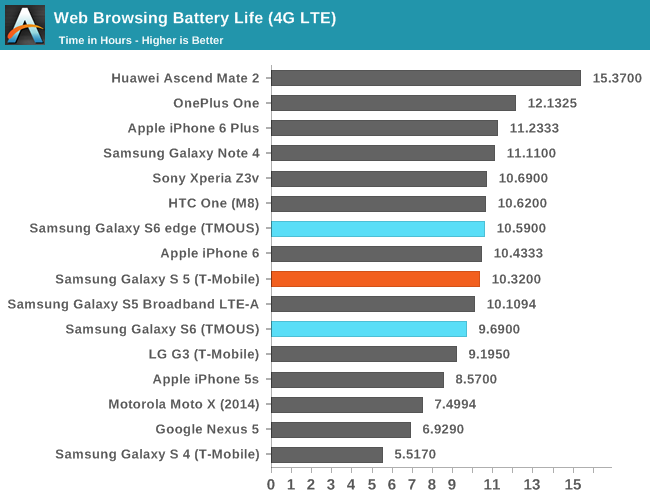
On LTE, we see a pattern that seems to generally mirror devices like the iPhone 6 with an external MDM9x25 Gobi modem. The Shannon 333 modem and Samsung’s other RF front-end components seem to be competitive with Qualcomm’s implementations, but given just how close WiFi and LTE battery life was with the Snapdragon 801 generation I suspect Qualcomm still holds an edge in average RF system power. The difference isn’t massive here, so it’s possible that this could simply be the difference between an external and integrated modem, but we’ll have to do a deeper investigation on power to be sure.
While web browsing is one of the crucial use cases, battery life experiences are often different when looking at multiple points in the curve. In order to get a better idea of battery life in less display-bound use cases, we’ll look at PCMark’s Work Battery Life test. Although not a fixed workload per unit time test like our web browsing test, it avoids strongly emphasizing display power at high APL scenarios and tends to be more CPU and GPU intensive, along with more mixed APL scenarios.

In this test, the Galaxy S6’s runtime in this battery life test is pretty close to the One M8 and One M9, but the major point of differentiation when compared to both is that the score throughout the test is significantly higher. It’s also important to note that the “battery” temperature during the test manages to stay much lower on the Galaxy S6 than on the One M9, which means that the SoC stayed in a more efficient mode of operation throughout the test as power consumption will rise with die temperature due to the way semiconductors work.
Now that we have a good idea of battery life in a display-bound and balanced workload, we can now look at SoC-bound workloads which include GFXBench and Basemark OS II. These tests are almost always limited by how much heat the case of the phone can carry away, and can often reveal weaknesses in how OEMs control throttling if a phone or tablet fails to complete either test. We’ll start by looking at GFXBench, which strongly stresses the GPU similar to an intense 3D game.

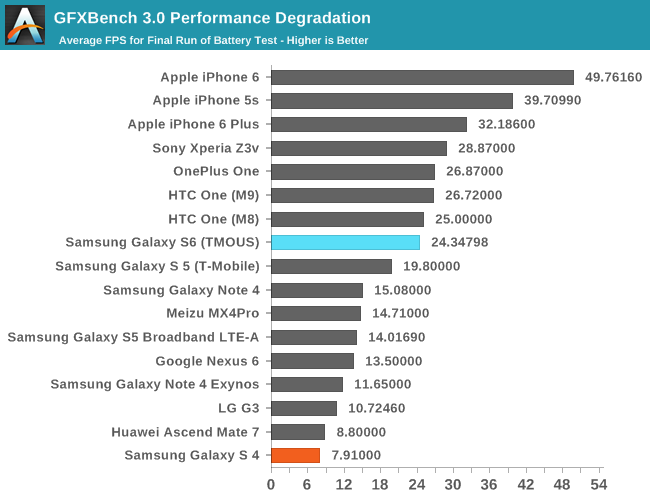
The Galaxy S6 ends up performing around the same level as the One M9 in terms of overall runtime, and the sustained frame rate ends up relatively similar as well. However, it’s critical to add context to this as the Galaxy S6 is running the test at 1440p, while the One M9 is rendering at 1080p. What this means is that the Mali T760 of the Galaxy S6 is sustaining a higher level of performance when compared to the Adreno 430 of the One M9 in this workload, even if that performance is “wasted” on rendering more pixels per frame. The one major issue here that is visible from the FPS vs time graph is that Samsung continues to struggle with graceful throttling as the GPU attempts to always target maximum performance, which causes a strong rise and fall in frame rate as the GPU goes through periods of high and low clock speeds determined by the thermal governor.
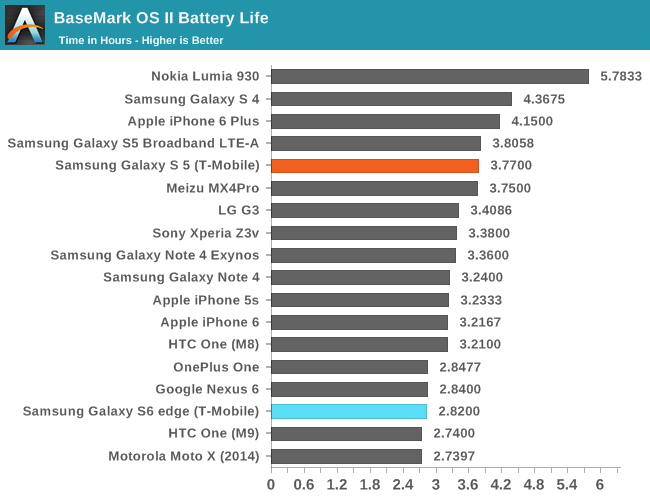
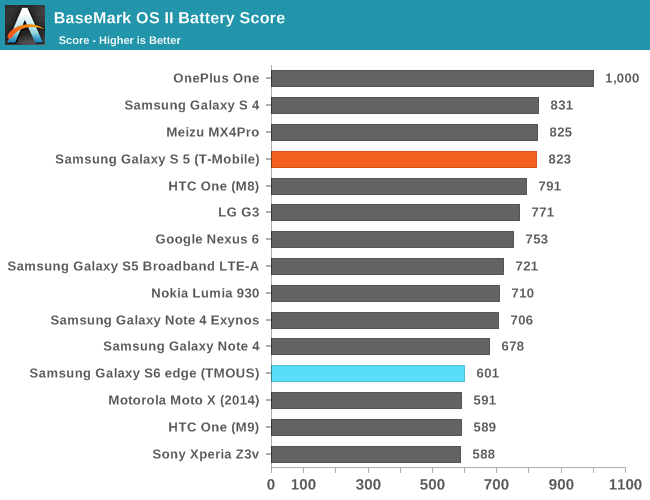
The final battery life test is Basemark OS II’s sustained CPU load test. Although it appears that the Galaxy S6 is comparable to the One M9 in this test, logging CPU frequencies over time reveals that the Exynos 7420 manages to keep the A57 cluster online throughout the course of the test at around 1.2 GHz, while the One M9 is forced to shut off the A57 cluster completely as the phone reaches skin temperature limits. Although both are kept at similar levels of normalized CPU load and run through the test for similar amounts of time, the Galaxy S6 manages to keep the CPU at a significantly higher performance level throughout the test. In general, it’s likely that the Exynos 7420 will be able to sustain overdrive frequencies for longer periods of time due to the massive process node advantages that come with Samsung’s 14LPE process.
Charge Time
Broadly speaking, much of the discourse around battery life as a whole has centered around time off of the charger. We can talk about how many hours of screen on time or total time a phone can spend on a battery, but charging time is often a critical to maintaining mobility. Removable batteries might be able to help with this problem, but if it’s easy to forget to charge a phone overnight, it’s just as easy to forget to charge a spare battery. Charge rate is often crucial for this reason, which is why we attempt to test it. In order to test this, we measure the time it takes to charge from a fully discharged battery to 100% either measured at the wall or indicated by a charging LED. The Galaxy S6 retains the same fast charge protocol as the Note 4, which seems to be QC 2.0 as the AC adapter negotiates fast charging with phones like the LG G Flex 2 and One M8.
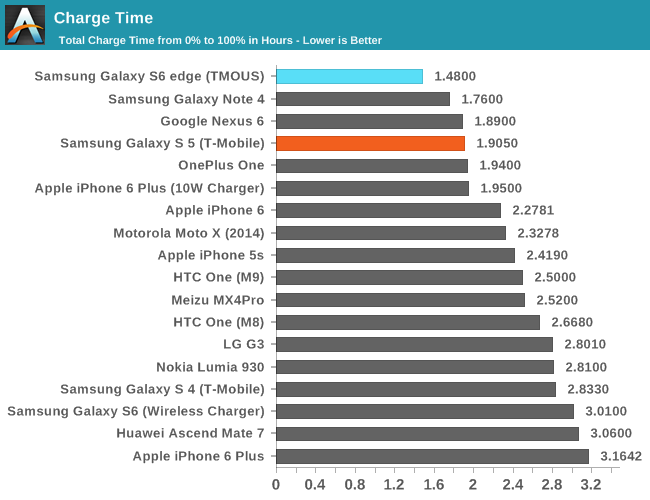
When using the included USB charger, the Galaxy S6 charges incredibly quickly. However, the wireless charger is noticeably slower than the wired charger, which is due to inefficiencies associated with wireless charging and the rather limited charge speed, which is appears to be limited to 1.5 amps at 5 volts. It’s a bit surprising to see that there is no option to disable fast charging the way there was with the Note 4 given that the battery is now sealed and rather difficult to replace, but I suspect most won’t notice a difference in lifetime unless the phone is used for more than 2-3 years.


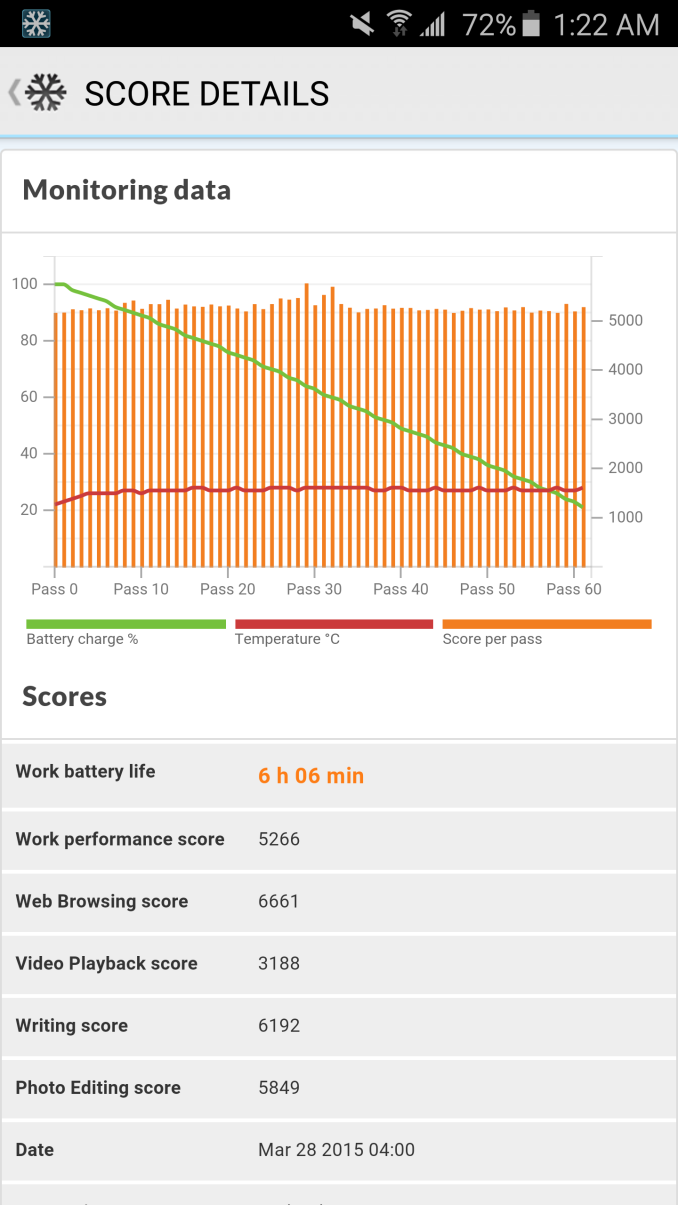
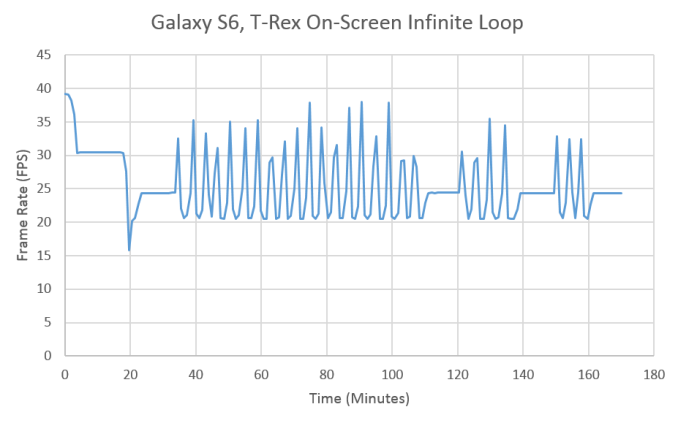
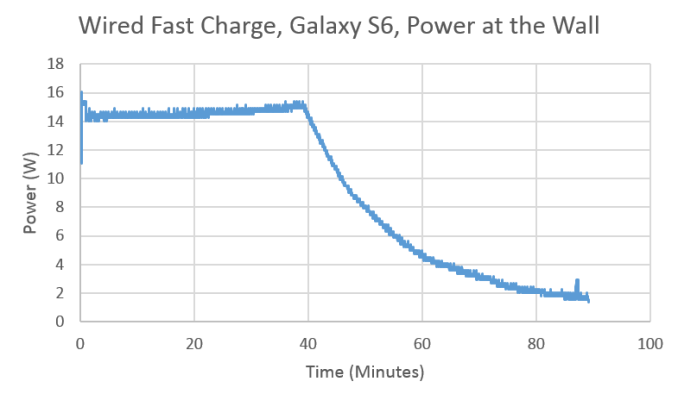
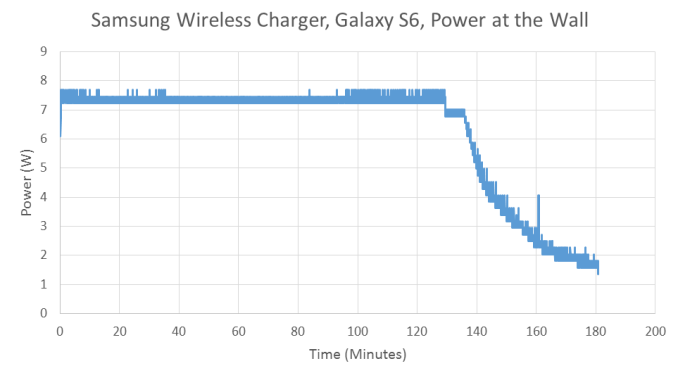








306 Comments
View All Comments
akdj - Sunday, April 26, 2015 - link
I'll re-read, but I could've sworn that was mentioned a couple times. Maybe it was ARS, but I'll check, as you're right. SVoice is the 'front end' to access GVoice and therefore allows Sammy to 'remember' your search information, etc. I've been able to work around, I believe, on my Note 4 now with the 5.0.1 updateUse Google Laincher. Disable Samsung account and sync and mine flies! Much faster than Nova, Go or vanilla TouchWiz and 'possibly' part of Google's Launch code, while using its only syncing data through Google (possibly SVoice or SRememberEverything in the background). I'll have to recheck and time but the update to LP has certainly sped all facets of the UI, updates, app launching and all around perceived 'speed'. I use a dark wallpaper, Nova Launcher 70% of the time and GLauncher the other portion.
Possibly Google's new 5.0.1 code is more specific to usage of its own services overriding those of carrier or the OEM. Again, unsure but damn it flies!
I'm going to spend this week with Google's camera to see if the Note 4 fan shoot the new raw still formats. As a decent camera with Lightroom on board and a CC subscription, I'm excited for the raw output of these hamdsets.
Are you speaking from experience? (Do you own one) or what you've read in reviews? I've certainly seen that mentioned and thought it was here ...pertaining to your suggestion it was forgotten. When I read it, I checked it in the Note 4 and using TW straight, indeed it runs through SVoice first with a significant delay (regardless of bandwidth). It seems quicker in Nova, slower in Go, fastest using Google Launch
pSupaNova - Tuesday, April 21, 2015 - link
Reading this review I can't help thinking Intel is in trouble if Samsung manages to ship lots of this handset.it will show that they are getting their SOC manufacturing into gear.
Schickenipple - Tuesday, April 21, 2015 - link
It's a little comical that a good portion of the 'pluses' of android phones have now gone the way of the iPhone. I fear there will be very little for Samsung lovers to hold over iOS soon.... How will you reboot when the OS freezes every day? Can't add an SD card??!! Blasphemy!Seriously though, they look pretty nice. Almost like an iPhone.
FlushedBubblyJock - Friday, April 24, 2015 - link
oh but if feels so industrial designed and so well built in my hand its so ergonomic my money impression is very, very high as my brain has been fried to a crisp from my desire to be somebody important and wealthy...FlushedBubblyJock - Friday, April 24, 2015 - link
excuse me but i have too go visit steve jobs grave for my monthly pilgrimage, and check my stock portfolio for my apple daily increase, an apple a day keeps retirement at bay !!!holmberg - Wednesday, April 22, 2015 - link
Could we get a measurement of the audio quality (i.e. the DAC and amplifiers, NOT the speakers), similar to what you did for the S5 here:;http://anandtech.com/show/8078/smartphone-audio-te...
FlushedBubblyJock - Friday, April 24, 2015 - link
oHHMMM ah I have recieved a premonition:When the time comes, metal industrial apple clone design won't be the glossy cocktail party rave it is now for all the reviewers... the new "nano carbon" hardshell and totally black design will be the inherently desired feel it up in the hand "win" the reviewers and crybabies all claim we want.
So, soon enough, when it's as cheap as a popcan is now, carbon fiber phone rage will storm the gates.... oh it's so light and so stiff, it feels so strong in my hand (like a fem commenting) ...
YEP - that's coming next - then after the reviewers convince the whole industry to trend toward carbon fiber and leave the metalheads in the dust (their newly created idiots wake) we will have another brain fart of gigantic proportion to deal with...
Warnings about carbon fiber slivers will go unheeded - there may be a whole section on how to reduce scratches and nano crackings and splittings of the fiber along with sales kits and superglue derivatives to rebond the nano cracks...
Next some of the more fervent feeler uppers will wind up in the hospital witth carbon paw poisoning or necessary eye cleansings since they sneezed up the raw carbon tubes into their own faces...
In the mean time they will have alzheimers from feeling up their aluminum metalized wonder industrial builds....
Yep, coming soon to a raw brain fart industry of elite 1% self love.
Forget that plastic if flexible, moldable, much more comfortable in the hand, lighter, and easily snapped apart and together - we must now have metal with apple 5star hex screws - and soon only carbon fiber probably with glass reinforced or ceramic fastener holes... and the elite will rave at the sensational high quality super high $$$$$ feel in their paws...
Yeah man, it's coming - if they charged ten grand for solidified rice paper the elite and feely nerd ego wackos would praise it to the moon and sky...
FlushedBubblyJock - Friday, April 24, 2015 - link
Where the heck is the scree resolution comparison and the pixels per inch chart putting the apple fans to shame ?I just read elsewhere the ppi which was always fanfare here when apple had the lead is 557 ppi ...
That's way above the 200-300+ I'm used to seeing...
So it's 4k resoluion and 557 pixels per inch - doesn't that deserve a whole page of glorious praise comparing to the other losers, which is everyone is it not ?
ubcjack - Tuesday, April 28, 2015 - link
Can Anandtech write an article to explain how Samsung implement PDAF over Sony's IM240 sensor? I'm really interested in the implementation.DIYEyal - Thursday, April 30, 2015 - link
If this phone was thicker with a bigger battery, dual sim, micro SD and waterproof it would have been the perfect phone for me.Rumors suggest that samsung is about to release a dualsim version, so I'll probably buy that.